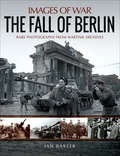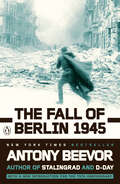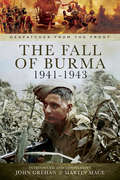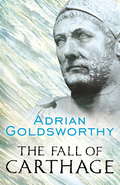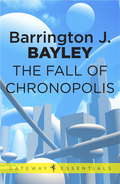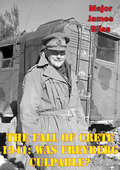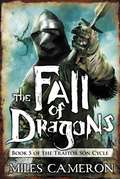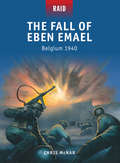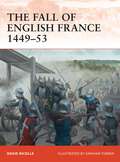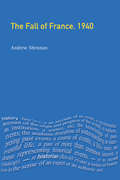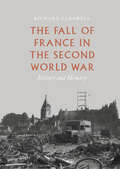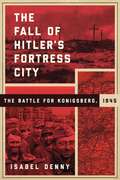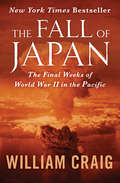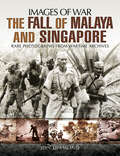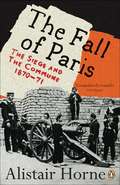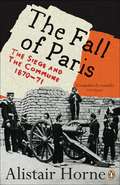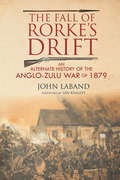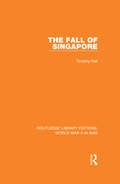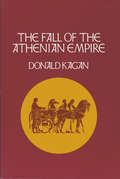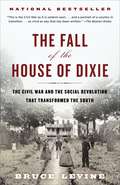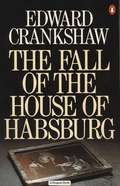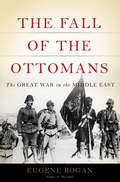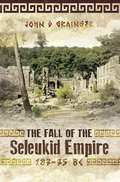- Table View
- List View
The Fall of Berlin (Images of War)
by Ian BaxterA photographic history of Nazi Germany&’s last days: &“The images are well chosen—this reviewer cannot recall having seen any before.&” —The NYMAS Review By March 1945, the Red Army had closed in on Berlin. Marshal Zhukov, with almost a million soldiers and 20,000 tanks and guns at his disposal, launched his assault of the Seelow Heights. While costly, with 30,000 Russians killed, it brought the Russian Army to the gates of the capital. On April 20, Hitler&’s fifty-sixth birthday, Soviet artillery began a massive bombardment of the doomed city. The Fuhrer ordered every soldier, Hitlerjugend, and Volksstrum to fight to the death. The house-to-house fighting that followed was brutal and savage, with heavy casualties for both military and civilians. Using superb Russian and German imagery, this pictorial history describes the Russian assault and Nazi last-ditch defense of Hitler&’s capital during the final days of the Third Reich.
The Fall of Berlin (Images of War)
by Ian BaxterA photographic history of Nazi Germany&’s last days: &“The images are well chosen—this reviewer cannot recall having seen any before.&” —The NYMAS Review By March 1945, the Red Army had closed in on Berlin. Marshal Zhukov, with almost a million soldiers and 20,000 tanks and guns at his disposal, launched his assault of the Seelow Heights. While costly, with 30,000 Russians killed, it brought the Russian Army to the gates of the capital. On April 20, Hitler&’s fifty-sixth birthday, Soviet artillery began a massive bombardment of the doomed city. The Fuhrer ordered every soldier, Hitlerjugend, and Volksstrum to fight to the death. The house-to-house fighting that followed was brutal and savage, with heavy casualties for both military and civilians. Using superb Russian and German imagery, this pictorial history describes the Russian assault and Nazi last-ditch defense of Hitler&’s capital during the final days of the Third Reich.
The Fall of Berlin 1945
by Antony BeevorAcclaimed for his vivid re-creations of some of the twentieth century's most significant battles, Antony Beevor is one of the best known and respected military historians writing today. He now offers readers a gripping, street-level portrait of the harrowing days of January 1945 in Berlin when the vengeful Red Army and beleaguered Nazi forces clashed for a final time. The result was the most gruesome display of brutality in the war, with tanks crushing refugee columns, mass rapes, pillage, and destruction. Hundreds of thousands of German civilians froze to death or were massacred because Nazi officials had forbidden their evacuation. Hitler, half crazed in his bunker, issued wild orders while Stalin was prepared to risk any number of his men to seize the city before the other Allies could get there. Making full use of newly disclosed material from former Soviet files as well as from German, American, British, French, and Swedish archives, Beevor has reconstructed the different experiences of those millions caught up in the death throes of the Third Reich. The Fall of Berlin 1945 depicts not only the brutality and desperation of a city under siege but also rare moments of extreme humanity and heroism. This account also contains new revelations about the motives behind Stalin's hurried assault. Sure to appeal to all readers interested in military history and the Second World War, The Fall of Berlin 1945 promises to be the definitive treatment of the subject for years to come.
The Fall of Burma, 1941–1943 (Despatches from the Front)
by Martin Mace John GrehanDespatches in this volume include that on operations in Burma between 15 December 1941 and 20 May 1942 by General Wavell; Operations in Eastern Theatre, based on India, March 1942 to 31 December 1942 by Field-Marshall Wavell; Operations in the Indo-Burma Theatre 21 June to 15 November 1942 by Field-Marshall Auchinleck; and Operations in the India Command 1 January to 20 June 1943 by Field-Marshall Wavell.This unique collection of original documents will prove to be an invaluable resource for historians, students and all those interested in what was one of the most significant periods in British military history.
The Fall of Carthage: The Punic Wars 265-146BC
by Adrian GoldsworthyThe struggle between Rome and Carthage in the Punic Wars was arguably the greatest and most desperate conflict of antiquity. The forces involved and the casualties suffered by both sides were far greater than in any wars fought before the modern era, while the eventual outcome had far-reaching consequences for the history of the Western World, namely the ascendancy of Rome. An epic of war and battle, this is also the story of famous generals and leaders: Hannibal, Fabius Maximus, Scipio Africanus, and his grandson Scipio Aemilianus, who would finally bring down the walls of Carthage.
The Fall of Chronopolis (Gateway Essentials #15)
by Barrington J. BayleyThe mighty ships of the Third Time Fleet relentlessly patrolled the Chronotic Empire's thousand-year frontier, blotting out an error of history here or there before swooping back to challenge other time-travelling civilisations far into the future.Captain Mond Aton had been proud to serve in such a fleet. But now, falsely convicted of cowardice and dereliction of duty, he had been given the cruellest of sentences: to be sent unprotected into time as a lone messenger between the cruising timeships. After such an inconceivable experience in the endless voids there was only one option left to him.To be allowed to die.
The Fall of Crete 1941: Was Freyberg Culpable?
by Major James BlissOn 20 May 1941, Generaloberst Kurt Student's Luftwaffe XI Fliegerkorps conducted the first operational airborne invasion in history to seize Crete. Major-General Bernard Cyril Freyberg VC, 2nd New Zealand Expeditionary Force, commanded the British forces defending the island. Freyberg, forewarned of the details of the invasion, possessed numerical superiority over the enemy, but was defeated within twelve days. Freyberg, later blamed for the defeat due to his perceived faulty defensive dispositions, was dealt a losing hand from the start. His troops consisted of those that could be rescued from the failed Greek Campaign and lacked sufficient weapons, communications, and transport to conduct the defense. Despite the best efforts of the Royal Navy, overwhelming Luftwaffe air superiority in the absence of the Royal Air Force isolated Crete and the relentless drive of the attacking German forces captured it. Poor tactical leadership by Freyberg's subordinate commanders and their failure to prosecute his operational plan led to defeat by the barest margin. While a tactical loss, Freyberg's destruction of the 7th Flieger Division resulted in Hitler never considering an operational airborne assault again. Freyberg, although accepting responsibility for the defeat, should not be held entirely culpable for the loss of Crete.
The Fall of Dragons (The Traitor Son Cycle #5)
by Miles CameronMiles Cameron is the master of intrigue and action-packed battles in this epic tale of magic and mercenaries, war, depravity, and politics, the final book of the Traitor Son Cycle.In the climax of the Traitor Son Cycle, the allied armies of the Wild and the Kingdoms of men and women must face Ash for control of the gates to the hermetical universe, and for control of their own destinies. But exhaustion, treachery and time may all prove deadlier enemies.In Alba, Queen Desiderata struggles to rebuild her kingdom wrecked by a year of civil war, even as the Autumn battles are fought in the west. In the Terra Antica, The Red Knight attempts to force his unwilling allies to finish the Necromancer instead of each other. But as the last battle nears, The Red Knight makes a horrifying discovery. . .all of this fighting may have happened before.
The Fall of Eben Emael - Belgium 1940
by Chris Mcnab Peter DennisIn early May 1940, the fortress of Eben Emael was a potent sentinel over the Belgian-Dutch borderlands. The fortress covered 75 hectares on the surface, had 5km of tunnels underground and was studded with bunkers, gun turrets and casemates. Add a garrison of 1,200 men and the natural protection of 60m-high canal walls, and Eben Emael gave the impression of near-impregnability. Yet on 10 May just 78 elite airborne soldiers managed to defeat this fortress in an operation of unprecedented tactical skill. Deployed by glider onto the very top of the fortifications, they utilized elite training, fast movement and specialist explosives to destroy many of the gun positions and trap much of the garrison within the fortress. Simultaneously, three other assault detachments conducted high-risk glider operations to capture critical bridges over the Albert Canal. By the end of 11 May, following the arrival of German infantry reinforcements, Eben Emael was in German hands. This Eben Emael RAID title tells the complete, fascinating story of this unique action.
The Fall of English France 1449-53
by David Nicolle Graham TurnerFor the overwhelming majority of people outside the French-speaking world the Hundred Years War consisted of a sequence of major English victories, above all Crécy, Poitiers and Agincourt. The only significant victor or 'hero' on the French side was Joan of Arc, and she ended up being burned at the stake. Yet somehow the war ended in a French victory and with England's martial energies being turned against itself in the Wars of the Roses. This book is intended to provide some balance. It will describe the campaign that brought the Hundred Years War to a close, with English possessions being confined to Calais and the Channel Islands. It will also explain how the somewhat unprepossessing and unmartial King Charles VII of France succeeded where his predecessors had failed. The campaign consisted of more than battles, of course, but it was marked by two major victories - at Formigny in 1450 and at Castillon in 1453. Formigny is of special interest because it saw French cavalry defeat English archers, in effect a reversal of Crécy, Poitiers and Agincourt, and could be interpreted as one of the last 'medieval' battles. Castillon is of interest because it was a victory of gunpowder artillery in fixed positions over a traditional medieval assault by mixed infantry and cavalry, and thus could be interpreted as one of the first 'modern' battles.
The Fall of France 1940
by Andrew ShennanOffering a fresh critical perspective on this momentous event, Andrew Shennan examines both the continuities and discontinuities that resulted from the events of 1940. The main focus is on the French experience of the war, but this experience is framed within the larger context of France's - and Europe's - protracted mid-twentieth century crisis.
The Fall of France in the Second World War: History and Memory
by Richard CarswellThis book examines how the fall of France in the Second World War has been recorded by historians and remembered within society. It argues that explanations of the fall have usually revolved around the four main themes of decadence, failure, constraint and contingency. It shows that the dominant explanation claimed for many years that the fall was the inevitable consequence of a society grown rotten in the inter-war period. This view has been largely replaced among academic historians by a consensus which distinguishes between the military defeat and the political demise of the Third Republic. It emphasizes the contingent factors that led to the military defeat. At the same time it seeks to understand the constraints within which France’s policy-makers were required to act and the reasons for their policy-making failures in economics, defence and diplomacy.
The Fall of Hitler's Fortress City: The Battle for Konigsberg, 1945
by Dennis Showalter Isabel DennyThe harrowing, tragic story of a city and a people ravaged by one of the most brutal battles of World War II.In 1945, in the face of the advancing Red Army, two and a half million people were forced out of Germany’s most easterly province, East Prussia, and in particular its capital, Königsberg. Their flight was a direct result of Hitler’s ill-fated decision to invade the Soviet Union in 1941. Now that the Germans were in retreat, the horrors of Leningrad and Stalingrad were to be avenged by an army determined not only to invade Germany but to take over its eastern territories.The Russians launched Operation Bagration in June 1944 to coincide with the D-Day landings. As US and British forces pushed west, the Russians liberated Eastern Europe and made their first attacks on German soil in the autumn of 1944. Königsberg itself was badly damaged by two British air raids at the end of August 1944, and the main offensive against the city by the Red Army began in January 1945. The depleted and poorly armed German army could do little to hold it back, and by the end of January, East Prussia was cut off. The Russians exacted a terrible revenge on the civilian population, who were forced to flee across the freezing Baltic coast in an attempt to escape. On April 9, the city surrendered to the Russians after a four-day onslaught.Through firsthand accounts as well as archival material, The Fall of Hitler’s Fortress City tells the dramatic story of a place and its people that bore the brunt of Russia’s vengeance against the Nazi regime.Skyhorse Publishing, as well as our Arcade imprint, are proud to publish a broad range of books for readers interested in history--books about World War II, the Third Reich, Hitler and his henchmen, the JFK assassination, conspiracies, the American Civil War, the American Revolution, gladiators, Vikings, ancient Rome, medieval times, the old West, and much more. While not every title we publish becomes a New York Times bestseller or a national bestseller, we are committed to books on subjects that are sometimes overlooked and to authors whose work might not otherwise find a home.
The Fall of Japan: The Final Weeks of World War II in the Pacific
by William CraigTold from both Japanese and American perspectives, this thrilling account of the final weeks of World War II in the Pacific has been heralded by the New York Times Book Review as "virtually faultless" By midsummer 1945, Japan had long since lost the war in the Pacific. The people were not told the truth, and neither was the emperor. Japanese generals, admirals, and statesmen knew, but only a handful of leaders were willing to accept defeat. Most were bent on fighting the Allies until the last Japanese soldier died and the last city burned to the ground. Exhaustively researched and vividly told, The Fall of Japan masterfully chronicles the dramatic events that brought an end to the Pacific War and forced a once-mighty military nation to surrender unconditionally. From the ferocious fighting on Okinawa to the all-but-impossible mission to drop the 2nd atom bomb, and from Franklin D. Roosevelt's White House to the Tokyo bunker where tearful Japanese leaders first told the emperor the truth, William Craig captures the pivotal events of the war with spellbinding authority. The Fall of Japan brings to life both celebrated and lesser-known historical figures, including Admiral Takijiro Onishi, the brash commander who drew up the Yamamoto plan for the attack on Pearl Harbor and inspired the death cult of kamikaze pilots., This astonishing account ranks alongside Cornelius Ryan's The Longest Day and John Toland's The Rising Sun as a masterpiece of World War II history.
The Fall of Malaya and Singapore: Rare Photographs From Wartime Archives (Images of War)
by Jon DiamondIn just 10 weeks from 8 December 1941 to mid February 1942, British and Imperial forces were utterly defeated by the numerically inferior Japanese under General Yamashita.British units fought hard on the Malayan mainland but the Japanese showed greater mobility, cunning and tactical superiority. Morale was badly affected by the loss of HMS Prince of Wales and Repulse to Japanese aircraft on 19 December as they sought out enemy shipping. Panic set in as military and civilians withdrew south to Singapore. Thought to be an impregnable fortress, its defences against land attacks were shockingly deficient. General Percival's leadership was at best uninspired and at worst incompetent.Once the Allied troops withdrew to Singapore it was only a matter of time before surrender became inevitable. To make matters worse reinforcements arrived but only in time to be made POWs.The whole catastrophe is brilliantly described in this highly illustrated book.
The Fall of Paris: The Siege and the Commune 1870-71
by Alistair HorneAlistair Horne's The Fall of Paris: The Siege and the Commune, 1870-71 is the first book of Alistair Horne's trilogy, which includes The Price of Glory and To Lose a Battle and tells the story of the great crises of the rivalry between France and Germany. The collapse of France in 1870 had an overwhelming impact - on Paris, on France and on the rest of the world. People everywhere saw Paris as the centre of Europe and the hub of culture, fashion and invention. But suddenly France, not least to the disbelief of her own citizens, was gripped in the vice of the Prussian armies and forced to surrender on humiliating terms. Almost immediately Paris was convulsed by the savage self-destruction of the newly formed Socialist government, the Commune. In this brilliant study of the Siege of Paris and its aftermath, Alistair Horne researches first-hand accounts left by official observers, private diarists and letter-writers to evoke the high drama of those ten tumultuous months and the spiritual and physical agony that Paris and the Parisians suffered as they lost the Franco-Prussian war.
The Fall of Paris: The Siege and the Commune 1870-71
by Alistair HorneThe collapse of France in 1870 had an overwhelming impact – on Paris, on France and on the rest of the world. People everywhere saw Paris as the centre of Europe and the hub of culture, fashion and invention. Suddenly France, not least to the disbelief of her own citizens, was gripped in the vice of the Iron Chancellor’s armies and forced to surrender on humiliating terms. In this brilliant study of the Siege and its aftermath, Alistair Horne evokes the high drama of those ten fantastic months and the spiritual agony which Paris and the Parisians suffered.The Fall of Paris is the first part of the trilogy including To Lose a Battle and The Price of Glory (already available in Penguin).
The Fall of Rorke's Drift: An Alternate History of the Anglo-Zulu War of 1879
by John LabandFor fans of Harry Turtledove, an alternate history novel in which Zulu forces triumph over the British at Rorke&’s Drift in 1879 and invade Natal. January 1879. The British Empire and the Zulu Kingdom are at war. Lord Carnarvon, Secretary of State for the Colonies, who had successfully brought about federation in Canada in 1867, had believed a similar scheme would work in South Africa. But such plans are rejected by Boer leaders. Lord Chelmsford leads a British military expeditionary force to enter the Zulu Kingdom uninvited. A bloody battle ensues on 22 January 1879 at Isandlwana. The Zulus are the unexpected victors. After that brutal defeat, the British Army are at Rorke&’s Drift on the Buffalo River in Natal Province, South Africa. A few hundred British and colonial troops, led by Lieutenants John Chard of the Royal Engineers and Gonville Bromhead, face the might of the Zulu army of thousands led by Prince Dabulamanzi kaMpande (CORR). Against the odds, the British are victorious, and this defeat marks the end of the Zulu nation&’s dominance of the region. The Defence of Rorke&’s Drift would go down in history as an iconic British Empire Battle and inspired Victorian Britain. Eleven Victoria Crosses were awarded to military personnel. But what if the Zulus had defeated the British at Rorke&’s Drift and invaded Natal? . . . In the first ever alternate history of the Anglo-Zulu War, historian John Laband asks that question. With his vast knowledge of the Anglo-Zulu War, he turns history on its head and offers a tantalizing glimpse of a very different outcome, weaving a compelling, never-before told story of what could have been.
The Fall of Rorke's Drift: An Alternate History of the Anglo-Zulu War of 1879
by John LabandFor fans of Harry Turtledove, an alternate history novel in which Zulu forces triumph over the British at Rorke&’s Drift in 1879 and invade Natal. January 1879. The British Empire and the Zulu Kingdom are at war. Lord Carnarvon, Secretary of State for the Colonies, who had successfully brought about federation in Canada in 1867, had believed a similar scheme would work in South Africa. But such plans are rejected by Boer leaders. Lord Chelmsford leads a British military expeditionary force to enter the Zulu Kingdom uninvited. A bloody battle ensues on 22 January 1879 at Isandlwana. The Zulus are the unexpected victors. After that brutal defeat, the British Army are at Rorke&’s Drift on the Buffalo River in Natal Province, South Africa. A few hundred British and colonial troops, led by Lieutenants John Chard of the Royal Engineers and Gonville Bromhead, face the might of the Zulu army of thousands led by Prince Dabulamanzi kaMpande (CORR). Against the odds, the British are victorious, and this defeat marks the end of the Zulu nation&’s dominance of the region. The Defence of Rorke&’s Drift would go down in history as an iconic British Empire Battle and inspired Victorian Britain. Eleven Victoria Crosses were awarded to military personnel. But what if the Zulus had defeated the British at Rorke&’s Drift and invaded Natal? . . . In the first ever alternate history of the Anglo-Zulu War, historian John Laband asks that question. With his vast knowledge of the Anglo-Zulu War, he turns history on its head and offers a tantalizing glimpse of a very different outcome, weaving a compelling, never-before told story of what could have been.
The Fall of Singapore 1942 (Routledge Library Editions: World War II in Asia)
by Timothy HallSingapore fell to the Japanese on 15 September 1942, but in 1941 Europeans on the island felt still untouched by war, lulled into security by the belief that Singapore was impregnable from the sea. However, the Planning Chief of Imperial Army Headquarters in Tokyo had realised a successful invasion could come from the north, down the Malay peninsula... Requests from less naive members of the allied forces for more men, arms and equipment were not filled. Authorities were unwilling to reveal to the civilian population the true situation. And so through accident or miscalculation, Singapore was totally unable to repel the Japanese attack. This accessible book, illustrated with black and white photos charts the course of these events.
The Fall of the Athenian Empire (A New History of the Peloponnesian War)
by Donald KaganIn the fourth and final volume of his magisterial history of the Peloponnesian War, Donald Kagan examines the period from the destruction of Athens' Sicilian expedition in September of 413 B.C. to the Athenian surrender to Sparta in the spring of 404 B.C. Through his study of this last decade of the war, Kagan evaluates the performance of the Athenian democracy as it faced its most serious challenge. At the same time, Kagan assesses Thucydides' interpretation of the reasons for Athens' defeat and the destruction of the Athenian Empire.
The Fall of the House of Dixie: The Civil War and the Social Revolution That Transformed the South
by Bruce LevineIn this major new history of the Civil War, Bruce Levine tells the riveting story of how that conflict upended the economic, political, and social life of the old South, utterly destroying the Confederacy and the society it represented and defended. Told through the words of the people who lived it, The Fall of the House of Dixie illuminates the way a war undertaken to preserve the status quo became a second American Revolution whose impact on the country was as strong and lasting as that of our first. In 1860 the American South was a vast, wealthy, imposing region where a small minority had amassed great political power and enormous fortunes through a system of forced labor. The South's large population of slaveless whites almost universally supported the basic interests of plantation owners, despite the huge wealth gap that separated them. By the end of 1865 these structures of wealth and power had been shattered. Millions of black people had gained their freedom, many poorer whites had ceased following their wealthy neighbors, and plantation owners were brought to their knees, losing not only their slaves but their political power, their worldview, their very way of life. This sea change was felt nationwide, as the balance of power in Congress, the judiciary, and the presidency shifted dramatically and lastingly toward the North, and the country embarked on a course toward equal rights. Levine captures the many-sided human drama of this story using a huge trove of diaries, letters, newspaper articles, government documents, and more. In The Fall of the House of Dixie, the true stakes of the Civil War become clearer than ever before, as slaves battle for their freedom in the face of brutal reprisals; Abraham Lincoln and his party turn what began as a limited war for the Union into a crusade against slavery by issuing the Emancipation Proclamation; poor southern whites grow increasingly disillusioned with fighting what they have come to see as the plantation owners' war; and the slave owners grow ever more desperate as their beloved social order is destroyed, not just by the Union Army, but also from within. When the smoke clears, not only Dixie but all of American society is changed forever. Brilliantly argued and engrossing, The Fall of the House of Dixie is a sweeping account of the destruction of the old South during the Civil War, offering a fresh perspective on the most colossal struggle in our history and the new world it brought into being.Praise for The Fall of the House of Dixie "This is the Civil War as it is seldom seen. . . . A portrait of a country in transition . . . as vivid as any that has been written."--The Boston Globe "An absorbing social history . . . For readers whose Civil War bibliography runs to standard works by Bruce Catton and James McPherson, [Bruce] Levine's book offers fresh insights."--The Wall Street Journal "More poignantly than any book before, The Fall of the House of Dixie shows how deeply intertwined the Confederacy was with slavery, and how the destruction of both made possible a 'second American revolution' as far-reaching as the first."--David W. Blight, author of American Oracle "Splendidly colorful . . . Levine recounts this tale of Southern institutional rot with the ease and authority born of decades of study."--Kirkus Reviews (starred review) "A deep, rich, and complex analysis of the period surrounding and including the American Civil War."--Publishers Weekly (starred review)
The Fall of the House of Habsburg
by Edward CrankshawHow the Habsburg Dynasty was destroyed as a result of the European wars of the early twentieth century.
The Fall of the Ottomans: The Great War in the Middle East
by Eugene RoganIn 1914 the Ottoman Empire was depleted of men and resources after years of war against Balkan nationalist and Italian forces. But in the aftermath of the assassination in Sarajevo, the powers of Europe were sliding inexorably toward war, and not even the Middle East could escape the vast and enduring consequences of one of the most destructive conflicts in human history. The Great War spelled the end of the Ottomans, unleashing powerful forces that would forever change the face of the Middle East. In The Fall of the Ottomans, award-winning historian Eugene Rogan brings the First World War and its immediate aftermath in the Middle East to vivid life, uncovering the often ignored story of the region’s crucial role in the conflict. Bolstered by German money, arms, and military advisors, the Ottomans took on the Russian, British, and French forces, and tried to provoke Jihad against the Allies in their Muslim colonies. Unlike the static killing fields of the Western Front, the war in the Middle East was fast-moving and unpredictable, with the Turks inflicting decisive defeats on the Entente in Gallipoli, Mesopotamia, and Gaza before the tide of battle turned in the Allies’ favor. The great cities of Baghdad, Jerusalem, and, finally, Damascus fell to invading armies before the Ottomans agreed to an armistice in 1918. The postwar settlement led to the partition of Ottoman lands between the victorious powers, and laid the groundwork for the ongoing conflicts that continue to plague the modern Arab world. A sweeping narrative of battles and political intrigue from Gallipoli to Arabia, The Fall of the Ottomans is essential reading for anyone seeking to understand the Great War and the making of the modern Middle East.
The Fall of the Seleukid Empire, 187–75 BC
by John D. GraingerThird in the trilogy of the ancient Greek dynasty. &“In Grainger&’s account, the fall of the Seleukid is as enlightening as the rise.&”—Minerva Magazine The concluding part of John D Grainger&’s history of the Seleukids traces the tumultuous last century of their empire. In this period, it was riven by dynastic disputes, secessions and rebellions, the religiously inspired insurrection of the Jewish Maccabees, civil war and external invasion from Egypt in the West and the Parthians in the East. By the 80s BC, the empire was disintegrating, internally fractured and squeezed by the converging expansionist powers of Rome and Parthia. This is a fittingly, dramatic and colorful conclusion to John Grainger&’s masterful account of this once-mighty empire. &“To get the best from The Fall of the Seleukid it would be worthwhile making sure you&’ve absorbed the first two volumes. Nonetheless you can enjoy and learn from this book alone. Like the fall of any other empire or the folly of human behavior—the story is compelling.&”—UNRV &“Grainger does a good job of producing a convincing narrative using the limited sources.&”—HistoryOfWar
